Photo

Inti Creates has rekindled my love for retro throwbacks... again. I shouldn't have been surprised; the studio's been killing it since Mega Man Zero and has only been keeping it up through 9, 10, and the Azure Striker Gunvolt games, just before dropping it dramatically onto the ground with a wet crunch (Mighty No 9). Yet even after leading the years-long disappointment parade of crowdfunded spiritual successors, they've hit the ground running with Bloodstained: Curse of the Moon.
For a crisp 10 bucks, I've gotten six hours of teeth-gritting joy and pain befitting of a classic Castlevania. Better, even! The difficulty curves satisfying hourglass shapes throughout levels, checkpoints bookending stretches of varied challenges and moments of respite, initially vast and methodical yet flying by on consecutive playthroughs with fluid play. Its bosses run laps around Cyclops or Frankenstein from Castlevania III, not least in spectacle; unlike III, Curse of the Moon's playable characters beg to be dynamically switched between mid-boss, each phase and attack pattern artfully counteracted by one of the four protagonists. The same holds true for levels, each crammed with screens custom-made for a particular sub-weapon or movement pattern.

(this archer shoots infinite arrows with knockback, barring entry unless you use Alfred's fire shield...)
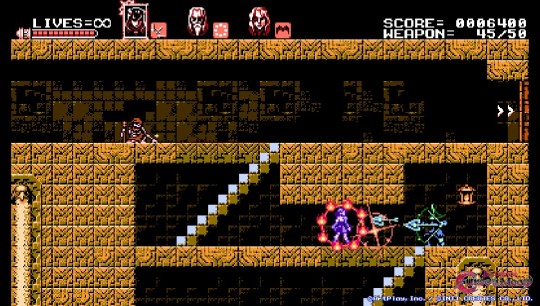
(... you can switch to a character with better range and damage to finish the archer off and access the branching path below without taking a scratch)
And even then, certain abilities (like Miriam's sliding kick and Gebel's bat form) perform similar functions (squeezing into crawl spaces). This, along with their differing health totals and sub-weapon costs, fleshes out initially simple decisions with wrinkles of depth. For example, many platforming sequences can be easily overcome with Gebel's bat form, but it'll quickly drain your magic points, leaving you fewer uses for powerful, long-range sub-weapons. There's a beautiful pain in being decimated by axemen and ghouls after feeling like I've cheated the system with Gebel, and later levels fill the air with foes to make this untenable as an easy out.
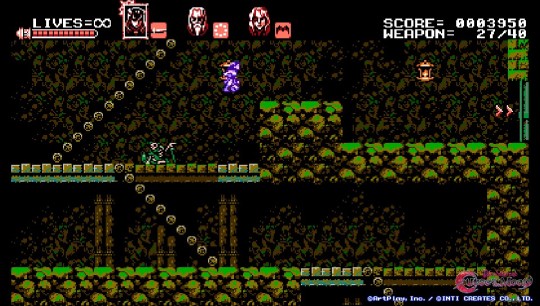
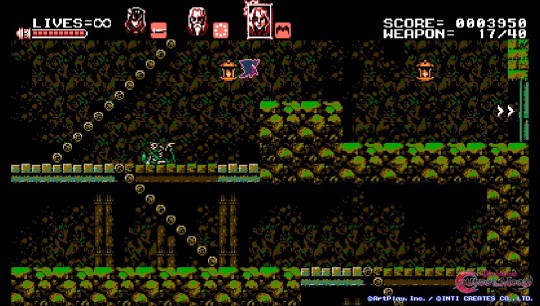
(Gebel's bat form can access any area Miriam can with her sliding kick or high jump, but his lower health bar makes him harder to keep alive)
Despite these specificities in level design, every stage is completable with any character, meaning even when all but your most neglected are knocked out, there's always a chance you can pull through. The game is meant to be replayed with various combinations of characters—all 4, only Zangetsu, everyone except Zangetsu, and so on—and each combination fundamentally alters the flow and difficulty of stages.
It's an exceptional feat of level design and a clever way to extend playtime, yet it's core to my looming disappointment with the game.
I spent at least 6 hours with Bloodstained, with an in-game time of 2 hours for each playthrough. That's meaty for an NES-style game! The first 4 hours rattled me to my core with obsessive adoration. It was on my mind while cooking, cleaning, playing other games... Yet as I spent my last 2 hours unlocking everything for this review, despite being challenged fairly and feeling my technique sharpen to a razor's edge... I ached. Because a significant chunk of the game for completionists will involve playing as Zangetsu and only Zangetsu.

Curse of the Moon has three modes of play (Normal, Nightmare, Ultimate), two difficulty settings (Casual, Veteran), and six endings largely determined by whether Zangetsu recruits, ignores, or kills the other three characters. On Normal and Ultimate, the game starts with only the demon hunter Zangetsu, and the first three stages allow you to recruit the rest of the cast. While playing the game for my own enjoyment, I recruited every character on Normal mode and immediately sprang into the newly-unlocked Nightmare mode which increases boss difficulty, features two unique stages, ditches Zangetsu, and lets you play as the other three right off the bat. I didn't mind this at all; the early stages have shortcuts that are only accessible in this mode, meaning there’s less repetition than you would first expect. And Zangetsu's moveset most resembles that of a Belmont but with the range of a shortsword, meaning he's the the least flashy and most difficult to play. In my initial run, I only used Zangetsu when my other characters were low on health. I didn't miss him on Nightmare.
But to unlock Ultimate mode, you must beat Normal mode with Zangetsu and only Zangetsu. If you kill Miriam, Alfred, and Gebel instead of recruiting them, Zangetsu gains extra powers to make the playthrough more manageable: a double jump, a dash, and a versatile aerial slash with a wide arc. But even this leaves you with a drastically reduced health-pool and a fourth of the versatility. Despite this run having the same playtime as my first two, it felt significantly longer. Even when inputting precise sequences of jumps, ducks, and alternating sub-weapons and attacks to optimize damage, it felt like a lesser experience. And Ultimate mode's the same game with Nightmare's harder bosses, Zangetsu's new moves, and a charged slash, making it largely pointless except to more easily unlock endings that involve sparing and abandoning party members. One of these endings is unlocked through another Zangetsu-only run. After accidentally recruiting Alfred in my attempt to win this ending on Ultimate, I decided to call it quits. I just wasn't having nearly as much fun without all my demonically empowered friends!
It's frustrating to love a game and have its playtime be extended with a shadow of its former self. Now, that shadow is very well-defined; Zangetsu-only runs feel like a classic, 1-character Castlevania without any of the bullshit. But because the refined character switching transcends its inspirations, offering variety, depth, and fluidity unfound in the old Castlevania trilogy, returning to just Zangetsu takes the wind out of my sails. Even with his extra kit, I miss the length of Miriam's whip, the unique aerial arc of Gebel's bats, and Alfred's devastating spells. And so does the game; signs and epilogues repeatedly lament what could have been when you go it alone. Maybe it's a profound piece of Gothic ludonarrative, but it's definitely less fun.
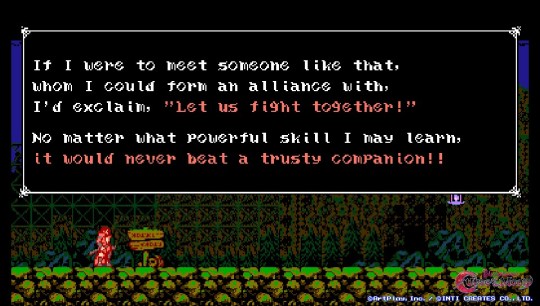
If you came for the consumer review elements and feel lost, know that you should buy this game. If I only got one ending on Normal, I would feel my money was well spent. But after that and a welcome extra helping in Nightmare mode, the game offered me more content with less depth and higher difficulty, leaving me stuffed yet unsatisfied. Somehow, playing the game I loved using all four characters unlocks only one of the six endings. In short, I wish Curse of the Moon extended its playtime by demanding more skillful use of its primary feature instead of removing it.

#bloodstained#bloodstained: curse of the moon#curse of the moon#bloodstained curse of the moon#castlevania#castlevania iii#review#game review#video game review#video games#game design
14 notes
·
View notes
Text
Kingdom Hearts Union χ[Cross] and fundamental failure

How do you judge a free-to-play mobile RPG? The kind with stamina timers, premium currency, and a "gashapon" that randomly dispenses characters and weapons? If you expect hours of uninterrupted play requiring dextrous, precise inputs, you're better off with a console game. But not even most portable console games can give you a satisfying play session within a lunch break, and most every mobile game can.
Although they're all intimately tied to a predatory monetization model, there's something special about a perpetual game on your phone. I hold fond memories of when Terra Battle or Tales of the Rays supplemented my life with structured play and planted a hobbyistic fervor in my mind with their clever, streamlined battle systems. There were post-launch story chapters and limited time events to frequently test my mettle, and when I just wanted to unwind, I was able to grind with easy content that didn't require my full attention. Despite some bursts of compulsive play and frustration with unlucky pulls, I felt I had mutualistic relationships with them.
My time spent with Kingdom Hearts Union χ[Cross] on Android, however, was largely parasitic. It neither provides stimulating enough combat to fully engross nor allows for the relaxing, hands-off play of an idle game. So, KHUX fails to provide the base pleasures of free-to-play mobile RPGs.

This game was first known as Kingdom Hearts χ[chi] on browser and originally for mobile as Kingdom Hearts Unchained χ, changing to its current name with a new co-op mode so unremarkable I neglect to mention it elsewhere in this review.
Battles are turn-based, and each of your attacks is derived from a medal (the primary gashapon item) slotted into your keyblade. You can tap on the screen to attack a single target, swipe the screen for a weaker attack that hits all foes, or swipe a medal to activate its special attack (they're officially named special attacks) requiring the use of a resource gauge called... "gauge." These always deal damage and may heal, grant buffs and debuffs, restore gauge, or grant ailments. Whenever you attack, the current medal rotates out to the next one until you've used each once.
Now, streamlining gets a bad rap. It's often associated with dumbing down instead of refinement. But there are so many mobile games that take advantage of their simplicity to make accessible depth. Just look at Puzzle & Dragon, the mobile puzzle RPG that requires thought and skill surpassing many of its pure action puzzler peers. In its case, shrinking the game board and allowing the free movement of pieces makes it easier to read a board WHILE offering superior board manipulation than the average match 3 (meaning more combos that you meant to make and less that come by chance). That's successful streamlining.

The medal system, unfortunately, doesn't use its simplicity for such an end. Each of your 3-7 medals must be activated one after the other in clockwise order starting with the first; your sequence of attacks is predetermined for every fight once you enter a stage. There's no dexterity or timing required for inputs. Ailments (largely useless) and enemy attack patterns are the only sources of randomization within combat, so there is no risk/reward dynamic.... and no choice. You either have enough gauge for a special attack or you don't. You either came with enough damage and healing to last or you didn't.
Though there's something resembling insight in the 1 Turn Triumph mechanic. You normally regain gauge piecemeal from damage dealt, but a 1 Turn Triumphs allow you to gain back multiple counts of gauge as long as you defeat enemies in a single turn. This requires consideration of enemy and medal attributes (red beats green beats blue) and damage distribution (single target or AoE). Clearing all enemies in a single turn is the most common requirement for objectives, optional achievements that grant currencies for character progression and the gashapon. Normally, you regain enough gauge to use special attacks at every opportunity, so you have to get a feel for how much damage you need to take out enemy formations in 1 turn, which will help you grind up enough gauge to defeat the stage boss.
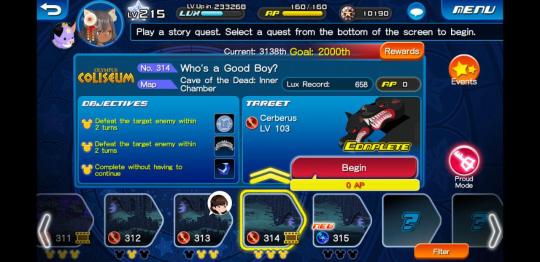
Sometimes, the same objective is repeated... within the same mission. Why?
The battle design is self aware of where mobile RPGs most disappoint; they can't make stages significantly challenging to complete without seeming to have a paywall, but if it's too easy, hardcore players will become disinterested. The game attempts to address this by assigning three objectives to each stage. These might require you to defeat all enemies in 1 turn, defeat bosses in a certain number of turns, or restrict which medals you may use to on attribute. So, allowing bad players to clear stages effortlessly while offering optional objectives accommodates everyone! Hooray! The game is designed, even at high levels, around players arranging their medals in the correct sequence before stages start instead of expecting them to think turn-by-turn. I find this to be a legitimate design decision for mobile (and console RPGs like Final Fantasy XII, for that matter). I hate it, but I respect it; it lets you take a laid-back approach to character management before battle and enjoy the results of your fine-tuned set-up.
Unfortunately, the game doesn't let you play effortlessly thanks to the lack of a true auto-battle. There's an auto setting that uses special abilities for you, of course, but it doesn't move you throughout the stage. You must navigate environments and encounter foes by laboriously sliding your finger across the screen—not with a virtual joystick, but across your entire screen.
There are mobile games that get away without auto-battle. For example, Fate Grand Order doesn't have basic attacks, and its skills are cooldown based or can expend variable amounts of meter for increased damage. A simple auto-battle routine couldn't easily tell whether you want to charge limit breaks, gain critical stars, burst down enemies, or activate unique character skills; the game is too complicated for it. Puzzle & Dragon wouldn't make sense with one in the same way an auto-play option wouldn't make sense for Bejeweled. But these two games are much more demanding, one for optimal order sequencing and the other with its puzzle board. You know, actively, traditionally-for-a-video-game engaging.
There's so little to this game's combat in the first place that I find it excruciating to manually navigate through its environments. They're expertly illustrated. Beautiful, even! But they work against the mindless, chill grind the battle system is meant to facilitate. The novelty of their beauty fades as you're forced to balance your phone in one hand and scrub dramatically across your entire widescreen phone to go from left to right and back again (how I wish it had a virtual joystick so I could play with one hand!). By the way, you have to touch and hold at the far edges of the screen to reach full speed. There’s an option to tap at a location, but the player character will vary its running speed depending on the distance away. It’s always a pain to perform movement, which doesn’t even factor into combat itself and often takes up more time than battle within a stage.

Keep in mind you have to scrub through this entire map dozens of stages in a row to clear the most common objective (defeat all enemies in 1 turn) at this scale:

If you're not used to playing mobile games, this might sound like a ridiculous complaint. But when the core combat is just an excuse to grind and make numbers go up, a shallow vessel to deliver the Good Chemical, it wears you down. Like, imagine if Cookie Clicker lacked store items that automatically produced cookies. KHUX is that kind of contradiction, a game designed to be passive that demands your attention in irritating, frequent pulses, an inconvenient hand cramp of a game.
There are more ways to play, extra mechanics, a baffling pet system... I won't go into everything the game has to offer, but know that they provide no depth to combat or medal management, merely complication. But I want to go over the main means of progression in the game: Guilt.
You level up medals to increase their power. You level up medals by fusing them together, losing all medals used to level the other. Their maximum level increases as their rarity increases. You can increases their rarity rank with materials you can grind for in daily objectives. I'll assume you understand how this kind of system works. Yet the game won't settle for this tried-and-true progression loop. It introduced the Guilt system.
So, every time you fuse identical medals together, the remaining one gets an orb (yes, it's just called an orb). The medals MUST be identical in both name and rarity. If the medal has any orbs, those are transferred to the base medal. If a 6* rarity medal (the rarest and most powerful rarity) gets all its orbs filled plus one, it rolls for a Guilt value. The Guilt value bestows a random percent bonus to damage up to 150%. Guilt value on the rarest of medals can range from 70% to 150%. What happens if you're unlucky and roll a 70%? Well, better go to the gashapon and pray for a copy! Even then, you might get a 71% and wasted a powerful medal. Good job!
The community encourages players to Guilt medals that drop freely through the story. This is the optimal sequencing of medal fusion to Guilt one of these medals:
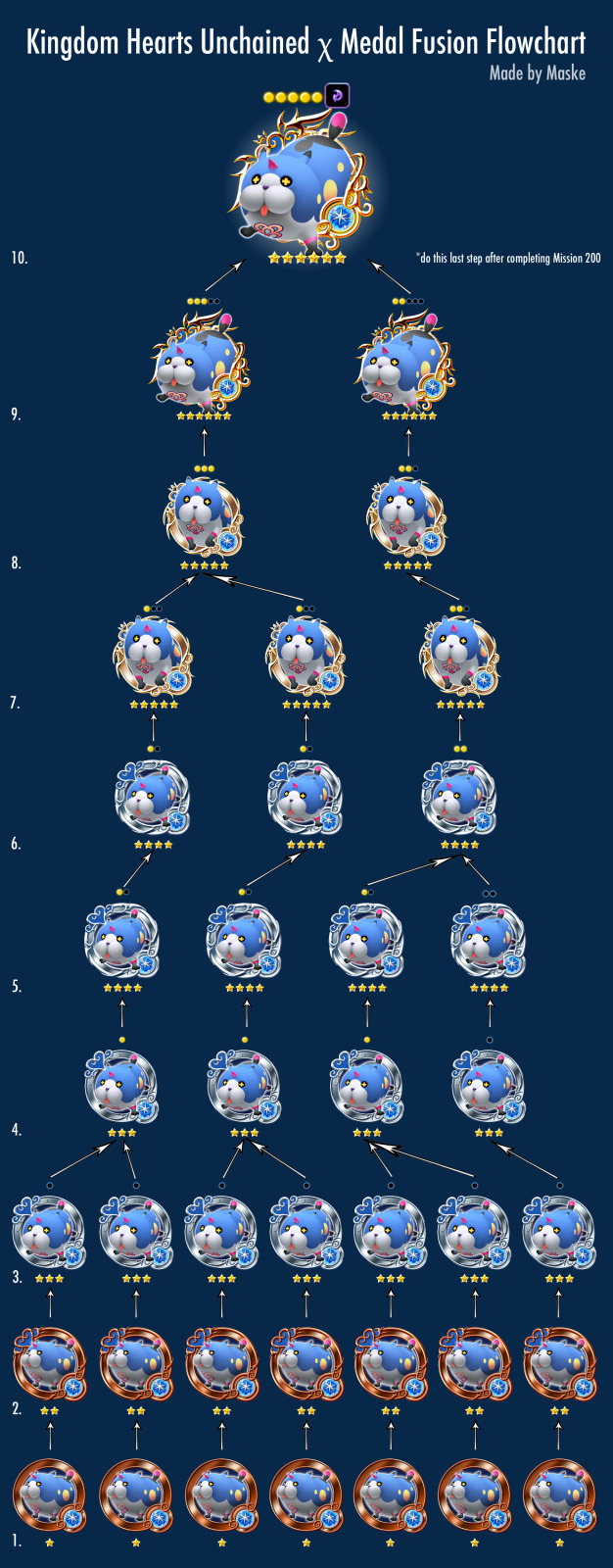
You need to, at minimum, 39 medals of the same name at different quantities for each rarity, AND all of the medals required to increase their rarity, AND all of the medals to level them up. If you don't do it in this exact sequence, you're wasting dozens of material medals and hours of time. It's absolutely absurd.
The game, of course, severely limits the amount of medals you can carry unless you pay with the premium currency. Even the joy of 10x gashapon rolls were tainted by the hidden tax of inventory expansion. Collecting medals should be fun. Collecting medals is what makes you want to spend money. Collecting and arranging medals is all the game is, really. And it's always accompanied with grueling, tedious inventory management that does nothing but stress me out!
I haven't even gotten to the power balance of medals. In short: it's whackadoodle. After making so much effort to Guilt my common 1* Stitch medals, I got lucky as a F2P player and rolled Illustrated Xion (EX). A single use of the medal buffs your damage with itself and all other medals by over 200% for multiple turns, refills more gauges than it takes to spend, and consequently breaks the majority of content over its knee. I never once, ONCE, in the entirety of the main story, had to manually choose which special abilities to activate to conserve gauge. And I had to manually move my character all the while, find an enemy, wait for the elaborate attack animations to cease, and start again. I stopped caring about clearing objectives; I was powerful enough to clear all of the story's content without bothering.
Other games use cost systems to prevent the abuse of rare medals at early player level, only allowing the use of one or two of the rarest kind of character or weapon. Due to a variety of factors involving the pace of progression, this did not factor in at all. Even without using all of my most powerful medals at once, Illustrated Xion (EX) was enough to utterly break what was meant to be a pacey, early-player experience. I ruined the game by getting a favorable gashapon roll. This is a fundamental failure in the design of randomized collectibles in a game I haven’t seen since the early days of mobile gaming. This has been solved for years.

By the way: I only started playing to see where the story would go. The community has reached a consensus that the plot only begins to develop significantly after stage 350, months and months after release. I would say it actually picks up in the early 300s, but by the time I got to the good parts, I was too bored out of my gourd to continue despite being greatly intrigued.
The game has built its entire postgame around the use of medals like Illustrated Xion (EX) that make all previous game content trivial. Half a year after introducing the first medal of this type, Illustrated Kairi (EX), there is now a permanent budget gashapon that has a paltry chances to drop these buff medals as a way to allow the unluckiest of players access to postgame. But I'll tell you: the postgame isn't worth it. It's a skilless test of how lucky you are or how irresponsibly you spend money. And if you can access it, your medals are too strong to enjoy any other content. There are no objectives asking you to bringing low-rarity medals to otherwise increase challenge. There is a Proud Mode variant for many story stages, but these have such strict restrictions that I could barely clear any of them (the most common of which restricts special attack use to medals that have been Guilted AND have a Guilt value exceeding a certain amount, which isn't nearly as hard as it is expensive). Even verifiable trash like Fire Emblem clone Phantom of the Kill has objectives requiring low-rarity characters to provide some bracing challenges.
In conclusion, Kingdom Hearts Union χ[Cross] fails to provide what I seek from a mobile game on a basic level: relaxation or engagement. It fails to relax me thanks to its hand-cramping map navigation and the oppressive inventory management. It fails to engage with its battle system because it's designed to be largely effortless and relaxing. It is a frustrating waste of time as a time waster.
1 note
·
View note
Text
Tokyo Xanadu ex+ and the bare essentials

Despite being a veritable JRPG junkie, I've only had a PS4 since the release of Nier Automata. I've been making up for lost time by racking up dozens of hours in Persona 5, Final Fantasy X, Tales of Berseria—any JRPG I could get my hands on. And none were as fun as Tokyo Xanadu ex+.
So when I say "fun," I mean "fun." Nier Automata is emotionally ambivalent, devastating, and brilliant! But not "fun:" every sword slash and sidequest is so fraught! Now, I'm delighted there are high-profile releases with greater ambitions than uncomplicated entertainment. But most JRPGs are less like philosophical bards than electronic jesters.
And we seem to judge them not on the endlessly repeated majority of their material but by the accompanying flashing lights (battle SFX, dramatic reveals after hours of stalling). It only takes a quick Google Image to see that Tokyo Xanadu doesn't have looks to fall back on; it's an enhanced port of a Vita game and looks it. It has the art direction of something you remember seeing in anime club but can't name.

Jon Peters, eat your heart out
And when I say "as fun," I mean "as frequently and intensely fun." No time loops or mandatory grinds or block puzzles, just talking, shopping, and hitting stuff.
That's not to say Tokyo Xanadu ex+ avoids the pacing issues typical of the genre. It's worse, actually, with dungeons flying by in 15-20 minutes after hours of town navigation and dialogue.The city of Morimiya is small, sparse, and surprisingly mundane considering it’s built on the edge of a Tokyo in ruins. And the story is episodic and largely plotless, so don’t expect to fall into a rabbit hole of lore and shocking turns of fate.
However, it’s a fully realized setting with pronounced cultural differences from modern day Japan and elaborately interconnected character relationships. Without counting your party members, there are over 70 named residents (hostesses, disgraced policemen, art curators, yakuza) that seem to have lives all their own. When they're not stuck in place or endlessly pacing across the same block, you'll find them popping up in unexpected places or combinations. Morimiya is like a diorama of a real place, teasing my imagination and curiosity.

This compares favorably to the modern Persona games. There, every NPC is either connected to a foreshadowing hivemind or so accurately depicting everyday conversation as to induce drowsiness. Here, my compulsive and periodic scan-through of the city rewards me with mildly pleasing tidbits. NPCs will be visiting each other in sickbeds or remembering a time before the Orbal Network revolutionized communication technology. I'm learning of the rivalries between major corporations or rediscovering that familiar shock when you realize your teachers have pasts and lives outside of school. It’s all in articles, blog posts, and dialogue boxes, and there’s a magic to their unsubtle, clumsy density.

(though, tying these tidbits to missable profile entries is a special kind of torture for completionists)
For how little time is comparatively spent in dungeons, they give great returns in entertainment value. They're easy to clear but require effort to S-rank (dungeons can be revisited at will in case you've scored low). Instead of expecting methodical exploration of elaborate dungeons, Tokyo Xanadu ex+ challenges you to clear simple dungeons as efficiently as possible.

After suffering through hours of alpha striking the same 6 encounters in Futaba's Palace and having every puzzle spoiled by the premature, overwrought yammering of dull teens... After effortlessly blinding the same giant bird 9 turns in a row between a half-dozen steps across the featureless Sanubia Desert... Oh, how sweet it is to dash through hordes of imps and golems, tearing through their health in seconds! How novel (sadly) to play a game that tests my speed and not my patience!
Combat is simple enough to make S-ranking exhilarating, not agonizing. You've got armor, shoes, two accessory slots, and a handful of gems for weapon slots with simple effects like "+10% ranged attack damage" and "+400 health." And here's the genius bit: there are only six attacks per character. That's right, six.

So, there are two limit breaks—one too many in my opinion, but they’re mechanically differentiated. I won’t go into it. There’s a basic attack button that mashes out close-range attacks. There are three special attacks mapped to the same button: ranged, flying, and power. They serve the same basic function for every playable character.
See, most JRPGs trick you into thinking they’re deep and strategic by piling on spells and special abilities, despite the massive overlap between them. Why does Persona 5 introduce 2 extra elements of magic damage? Why do so many games have multiple damage-over-time status effects (e.g., poison and burn)? You spend accumulated hours micromanaging which categorically-differentiated, mechanically-identical skills you’ll learn despite their comparative use being determined only by their distribution among enemy weaknesses. Most spells aren’t even useful, full stop. You're left with a small handful of useable options whose applications are obvious and one-dimensional. There's surprisingly little meaningful choice despite the paralyzing amount of choice.
In Tokyo Xanadu, ranged attacks… are ranged attacks... that shoots projectiles. Flying attacks cause a character to burst forward a great distance at high speed, doling out multiple hits along the way. Power attacks stick you in place for a massive burst of damage with moderate range, can break enemy guards, and greatly reduce damage taken while they’re happening. You can only use ranged attacks on the ground and flying attacks in the air. Power attacks require the special attack button to be held down, activating after a delay. If you’re out of SP, you can wait for it to refill or speed up the process with basic attacks. And these are the only actions you need to create a satisfying combat system.
Let me compare my experience with this game to Tales of Berseria, an entry in Namco-Bandai’s flagship action RPG series. In Berseria, each of the 6 playable characters has dozens of special skills you can freely map onto a 4x4, non-linear combo tree. Each enemy has multiple weaknesses based on race and element, and you need to hit them all to guarantee hitstun. Sound impressive?

Well, I ended up making 1 combo string for each type of enemy in an area and spamming it endlessly. I played on the hardest available difficulty for most of my 40 hours with the game, largely unchallenged. Its complications did not produce a game with a diversity of player input because the value of an attack string is mainly determined by how quickly it hits all of an enemy's weaknesses. Map attacks with total coverage to one button, mash, and win. Harder difficulties merely increase your likelihood of contracting a repetitive stress injury.
Tokyo Xanadu, meanwhile, encourages me to choose actions based on their unique utility, range, and movement. Here’s a common scenario: a boss rushes in my direction, covered in flames. I dodge roll out of the way. While they’re still ablaze, I hammer out a couple ranged attacks. Just before the flames settle, I charge in with a flying attack! I only got a couple hits in at the very end, but now I’m in range for a power attack—but I’m low on SP. Ok, while they’re recovering, I’ll mash out a combo, and—there’s the windup—bam! And another! Now, can I keep taking reduced damage with power attacks or should I take the slow route and dodge? Oh shit, it’s coming at me again!

This is the kind of routine that defines Tokyo Xanadu’s combat. There’s always a risky way to optimize damage, yet even cautious play is tense and high-octane, especially on Nightmare difficulty, where single hits chop through thirds or halves of your health. And each character has their ups and downs; most ranged attacks plant the character in place, but the first-year hacker stays mobile while shooting. The main character lets out an unusually wide power attack in a circle around him, giving him the best AoE attack. The party tsundere is an all-rounder with a pathetic flying attack, unsuited for approaching distant bosses.
Yeah, there’s an uninspired elemental weakness system. But the singular focus of each enemy’s design adds a small wrinkle of depth; a dangerous, close-range boulder’s weakness to wind is dangerous for your wind-element karate kid to approach, and her ranged attack is piddly. Do you compromise her melee focus for safer kills? Well, her flying attack is excellent, so I’ll pair her with the tsundere…
It’s on the easy side, cliché, and dead simple, largely unimpressive on the surface. It’s a mid-budget game at full price in a market dominated by gorgeous AAA games and cheap indie darlings. But if you like JRPGs and are as interested in the danger of a friend’s life as the fate of the universe, consider picking this game up. It’s as ruthlessly decompressed, needlessly wordy, and lopsided in pace as its peers, but there’s a surprisingly elegant core where most major JRPGs are fat and gristle all the way through. Tokyo Xanadu ex+, unlike most of its genre peers, doesn’t want to impress you with vestigial maximalism or pretense. It wants you to have a good time.

29 notes
·
View notes